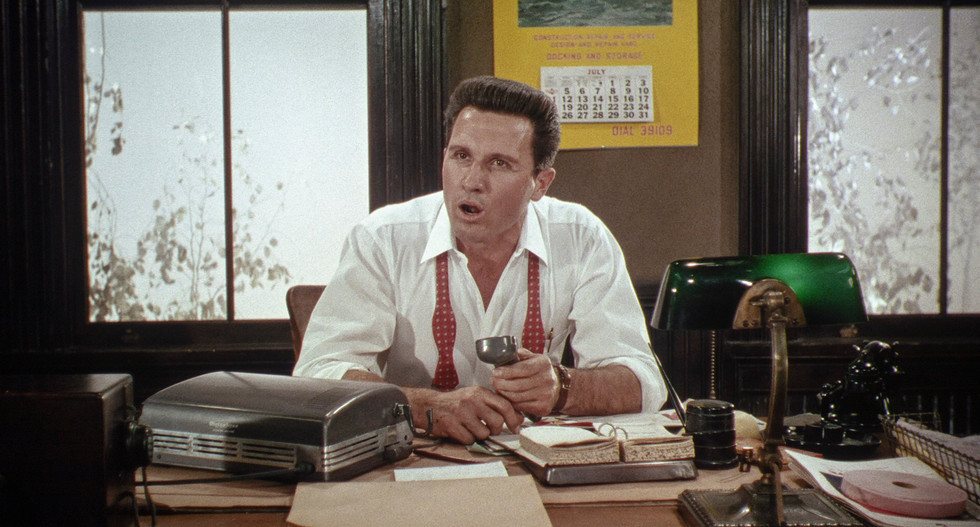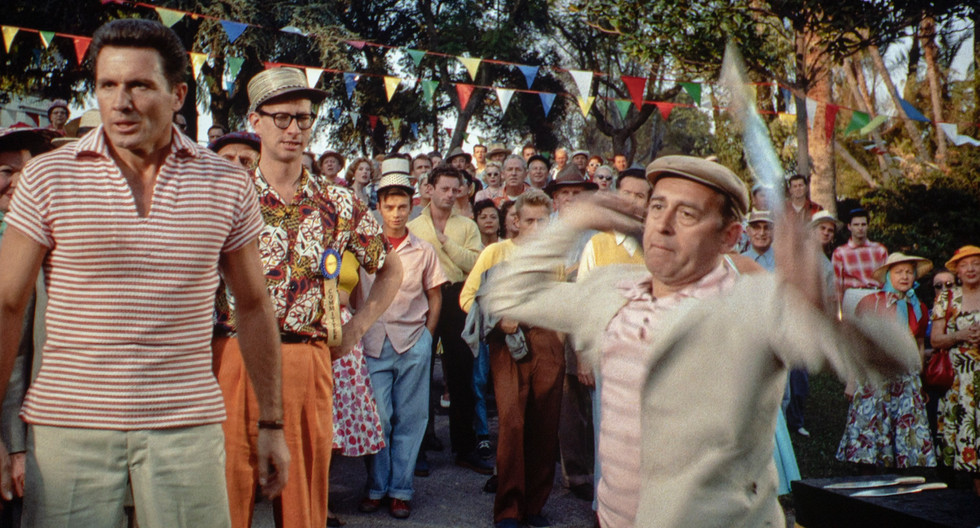Brilliant color rules “The Pajama Game” – Warner Archive Collection
- Kay Reynolds
- Mar 2, 2021
- 5 min read
Updated: Jun 24, 2022
BLU-RAY REVIEW / FRAME SHOTS

Day One: the new floor manager Sid Sorokin (John Raitt) meets the factory grievance committee and Union liaison, Babe Williams (Doris Day).
(Click an image to scroll the larger versions)
“THE PAJAMA GAME” – WARNER ARCHIVE COLLECTION
Blu-ray; 1957; Not Rated
Best extra: Deleted song, “The Man Who Invented Love”
IT LOOKS GOOD in its new 4K master made from the original 35mm film source. And the cast headed by Doris Day, with choreography from Bob Fosse, is a prize.
What could throw viewers off is the 1950s humor – or what passes for it. Picture a pajama-making sweat shop environment with women dressed in colorful Donna Reed attire and full make-up, sans pearls. A foreman, Vernon “Hinesie” Hines (Eddie Foy Jr.), stalks his former fiancée, Gladys Hotchkiss (Carol Haney) with a knife. He’s a former circus performer, who throws blades at any man who talks to Gladys. He eventually threatens to kill her. (Like no one saw that coming, but ha-ha, kids!)
The new floor manager, Sid Sorokin (John Raitt), hits on the leader of the factory grievance committee and Union liaison, Babe Williams (Doris Day) as soon as he meets her. Sid says he’s establishing a new work policy where “everyone will get along.” Then kisses Babe, asking her to “be my girl,” pursuing her throughout this musical rom-com. She eventually falls for him because rom-com musical, right? Written by, directed by and produced by men, this is all the stuff of male fantasy.
(1) John Raitt as Sid Sorokin reprises his Broadway role. He meets Sleeptite Pajama Factory boss Myron Hasler (Ralph Dunn) while interviewing for the job of superintendent. (2) The factory floor ensemble sings “Racing With the Clock.” (3) Babe and the ensemble sing “I’m Not At All in Love.” (4) Sid sings “Hey There,” the musical's most famous song. He creates his own “back-up” chorus with the clever use of a dictaphone.
Meanwhile, the boss of Sleeptite Pajama Factory, Myron Hasler (Ralph Dunn) denies his employees the 7½ cents @ hour raise that has recently become the national norm for all factory workers. He tells everyone the company hasn't approved it. The punch line to that – and it’s a doozy – brings on the standard happy ending. There are no people of color throughout … except for one black child flashed at the entrance of Hernando’s Hideaway, and he’s a servant.
We’ve come a long way since the ‘50s, and thank goodness for that.
“The Pajama Game” musical is based on “7½ Cents,” a book by Richard Bissell. The movie is a direct adaptation of the Broadway hit featuring most of its original cast, with Day stepping into the lead female role. The part seems made for her and she shines whenever she appears. According to TCM, co-writer George Abbot wanted Marlon Brando (“Guys and Dolls”) to play the male lead; the studio wanted Frank Sinatra, and Bing Crosby was “interested, but unaffordable.” John Raitt, singer Bonnie Raitt’s father, reprised the part he played onstage.
“The Pajama Game’s” story about management vs. labor played better in the ‘50s and ‘60s. Today, it’s overwhelmed by its ugly social conventions, and an abundance of full-cast musical numbers that have lost their appeal. It only had three hit pieces, “Hey There,” “Steam Heat” and “Hernando’s Hideaway.” Oddly, except for the “Hey There” reprise, Day is featured in only five out of 24 musical scenes.
Such were the times. Co-director Stanley Donen would go on to direct mystery-thrillers “Charade” (1963) and “Arabesque” (1966). Prior to “The Pajama Game,” he directed musical classics “On the Town” (1949), “Seven Brides for Seven Brothers” (1954) with its groundbreaking dance numbers, and “Singin’ in the Rain” (1952).
(1) The annual factory picnic sequence was filmed at Hollenbeck Park in Los Angeles. (2-4) Drunken foreman and “efficiency expert” Vernon “Hinesie” Hines (Eddie Foy Jr.) shows off his knife-throwing skills at the picnic. (5) Babe and Sid become a couple singing “Once-A-Year-Day” with the ensemble cast.
Doris Day, America’s Sweetheart whose personal life was more tragedy than comedy, leapt into “Pajama Game”just after a dramatic turn in Hitchcock’s “The Man Who Knew Too Much” (1956), co-starring Jimmy Stewart. She was a hardworking film and TV star whose credits include “Please Don’t Eat the Daisies” (1960), “The Glass Bottom Boat” (1966) and “Pillow Talk” (1959) with frequent co-star and friend Rock Hudson. She became an international champion for AIDS when she welcomed Hudson, who soon died from the disease, on her show. He was the first guest on “Doris Day’s Best Friends” in 1985 when AIDS was still “the mystery disease” and its victims were shunned. Day retired to become an animal rights crusader. Her songs are still heard on shows such as “Mad Men,” “Call the Midwife,” “Bates Motel,” “The Handmaid’s Tale,” HBO’s “Watchmen,” “The Marvelous Mrs. Maisel,” and “The Boys in the Band” (2020).
Warner Brothers ownership of their library and MGM’s makes them the king of movie musicals including “The Music Man,” “Yankee Doodle Dandy,” “Cabaret,” “Victor Victoria,” “Guys and Dolls,” and “An American in Paris.” “Show Boat” and “Damn Yankees” are next to be released. So the lackluster “Pajama Game” is something of a fluke.
VIDEO
Still, the movie is a stunner with its upgraded 1080p presentation. “WarnerColor” sparkles with bold, rich, saturated primaries. Skin tones are perfection with its clean-cut, ‘50s style makeup and hair-dos. Fabric used as pajamas, backdrops, and costumes is vibrant. All of those shirtwaist dresses swirl with movement, and a pajama fashion parade closes the film. Details, contrast and clarity are good.
Harry Stradling of “My Fair Lady” (1964), “The Picture of Dorian Gray” (1945), “A Streetcar Named Desire” (1951) and Alfred Hitchcock’s “Suspicion” (1941) was the cinematographer.
(1-4) Babe deflects Sid’s affections - again - in “Small Talk” and “There Once Was a Man.” But romance returns just as negotiations between management and factory workers grow more intense.
AUDIO
The mono DTS-HD Master Audio 2.0 track is good, all cleaned up and providing clear delivery of dialogue, effects and music. But the music presentation is kinda ho-hum. This is not an error of transition, but the original soundtrack. A stereo format was available and would have surely helped.
Music and lyrics are by Richard Adler and Jerry Ross, who also wrote the score for “Damn Yankees.” “The Pajama Game won the Tony Award for Best Musica”l in 1955.
EXTRAS
The trailer is always the best way to judge how well Warner Archive has remastered the movie, as well as fun to hear and watch the classic pitch. This one is no different.
The other bonus feature is a deleted song performed by Doris Day, “The Man Who Invented Love.” It’s a nice inclusion, but easy to see why it was replaced by Day’s reprise of “Hey There.” Warner Archive again showcases the musical numbers with a feature that allows viewers to jump to specific songs.
Doris Day shines in every moment she has onscreen, a plus for fans. Fosse choreography in two hit songs are also winners. As long as you can ignore the antiquated behaviors, “The Pajama Game” is an entertaining indulgence.
— Kay Reynolds
(1) Union Leader Prez (Jack Straw), a skirt chaser and married man, leads a talent show to raise funds and spirits. (2) Gladys Hotchkiss (Carol Haney) performs “Steam Heat” with two co-workers. (3) Trusting Sid to resolve the labor dispute, Babe tenderly reprises “Hey There.” (4) Prez and Babe stall for time describing the importance of the “7½ Cents” raise. (5) All’s well that ends well with a pajama fashion show.





































Comments